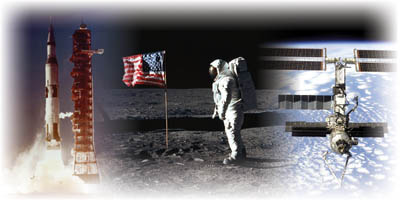
On July 20, 1969, 35 years ago this month, Neil Armstrong took a small step for man and a giant leap for mankind.
The Apollo 11 trip was the culmination of a nearly decade-long pledge made first by President John F. Kennedy in May of 1961 and continuing on for eight years, spanning years that included the assassination of a president and the inauguration of two other presidents. In many ways, the lunar landing was the realization of an innate desire of humans that has been forged throughout the millennia. While President Kennedy may have declared our intentions to go to the moon by the end of the decade, the desire has been there since mankind's Homo Sapien progenitors lay on the grass looking up at the moon and stars.
Today, there is a new President in office, and a new vision for space being debated, much like 35-years ago. While President Kennedy may not have been enamored of space travel-in reality, Kennedy, still reeling from the Bay of Pigs fiasco, cared more about curtailing the spread of communism and reversing the perception that Democrats were soft on communism-and yet he was able to inspire a nation to do, and fund, the monumental work of going to the moon.
This year, the country is led by a President who is waging a war to contain a menace to the democratic way of life, and who is again looking to the stars to inspire a nation. He is also hoping to bring new technology with real-world applications to the country.
Along the way, there have been the stunning successes of the space programs, Mercury, Gemini and Apollo, and the post-moon programs including the space shuttle and now the International Space Station.
Throughout these successes, behind the scenes, away from the newsprint and network TV, are the thousands of scientists, engineers and quality assurance personnel who have tested, inspected and measured hundreds of thousands of parts. Much as today there is a difference of opinion regarding the need to inspect every part, so too was there that debate during the Apollo program.
Wernher Von Braun, the eminent German scientist who emigrated to the United States as Hitler's regime was falling, believed in checking every part. Von Braun, who wrote a book outlining how to travel to Mars, would insist on every part be tested before it went into a rocket engine.
James Webb, NASA Administrator at the time, felt differently. Essentially, with more than 500 contractors working on both large and small aspects of Apollo, he felt it was taking to long and costing too much. Webb, as a NASA history of the Apollo program points out, felt that the contractors, who provided millions of parts and components, met exacting specifications for performance and reliability and that Von Braun should "trust American industry" and accept the parts.
Despite NASA's great successes, through the years, the agency has been bloodied, lives lost. It has responded each time with an investigation that found holes in the way the ships were designed, built, managed.
The thorough investigations led to changes. Apollo 1 had caught fire, an investigating board had learned, because of a short circuit in the electrical system that ignited combustible materials in the spacecraft fed by the oxygen atmosphere. The board, according to NASA's Project Apollo: A Retrospective Analysis, found that it could have been prevented and called for changes, including a less oxygen-rich environment in which too work. The changes were made and in about a year, Apollo was ready to fly.
Similarly, in 1986, the Challenger broke apart 73 seconds after launch. The investigation discovered that a leak had occurred in one of two rocket boosters caused by faulty joints. The fuel leak ignited the liquid fuel tank. The investigation resulted in changes in the solid rocket booster and was meant to solve communication problems that curtailed information reaching the correct individuals.
The Columbia, in 2003, has been thoroughly investigated and the causes, both direct and indirect, are known. Potential causes were dissected, and new recommendations by this independent board, which NASA administrator Sean O'Keefe has pledged to follow, were made including recommendations to incorporate new nondestructive test and evaluation technologies, redesigned components, and improved communication between all levels of management.
Seventeen years after Challenger, when the Columbia shuttle was destroyed, investigators would go back and try to determine if all the recommendations were made. They found that most had, but some hadn't, including procedural and organizational changes requested at that time. This time, NASA administrators vowed, they would not fly until all the recommendations of the Columbia investigators were enacted and the shuttle was safe to fly.
The truth is, of course, that if they could strap a 1959 Corvair to a booster, NASA would still have applicants queuing up not just around the block, but across oceans.
Each recommendation will be implemented and, as history tells us, the ships will again breach the sky. The shuttle will fly and will help complete the International Space Station-that human-made dot, that glowing star-like beacon.
Then the shuttle will find itself relegated to history; remembered in video and images and a Smithsonian Institution collection located at Washington Dulles Airport. New ships will take their place. Perhaps, if the new plans for the future are enacted, humans will touch the soil of an alien, oft world, ground-first to the moon and then, to mars!
Will it be NASA in its current form that deposits men and women on far away planets? That is an unknown. The President wants to open up space to the private sector. Already, one privately-funded space shift, the SpaceShipOne, has flown into space. What is sure to happen though is that mankind will continue to test the boundaries of space, because as Von Braun says, it is another step along mankind's evolutionary path.